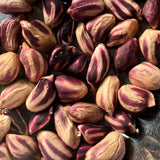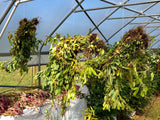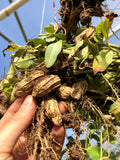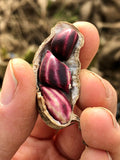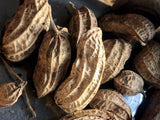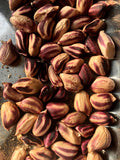Transkutukú Peanuts
Arachis hypogaea
The Transkutukú Peanut is mesmerizingly beautiful, with remarkable striped coloring ranging from pale pink to deep fuschia. Its pods are curved, and more crescent shaped than other varieties of peanut I've seen. Its shells are deeply ridged, with pronounced alligator-skin-patterning, and are tougher to crack. It grows as a small bush, with lots of sprawling runners, which in our experience were the most heavily laden with peanuts. This peanut comes from the Shuar and Achuar communities of the Morona Santiago jungle, Ecuador. Shuar people are recognized as the ancestral keepers of these seeds. They are indigenous to Ecuador and Peru in the Condor Range and the Transkutukú Amazon region in the lowlands of the Zamora and Upano river basins.
These peanuts are considered important to this region both because of their unique beauty, their sweet and salty flavor when roasted, and because of the ancestral cultivation techniques practiced for hundreds of years by the Shuar of this jungle area.
In the Shuar and Achuar languages, peanuts are called Nuse. In Spanish, this variety is called Maní De Transkutukú. In English, these seeds are sometimes called Fastigiata Pin Stripe Peanut and Jungle Peanut.
For more information about the traditional growing of this particular peanut, please see this video at 8:34: https://youtu.be/2QCK0jNWcMc.
Our Truelove Seeds coworker Maebh Aguilar, whose father is from Ecuador, tended to these peanuts with special care in our field, and has this to add to the description:
"Peanuts are a staple in Andean cooking, and the Ecuadorian dishes I grew up eating are no different. Whether it's salsa de maní atop our llapingachos (cheese-stuffed potato patties) or as a thickener in our celebratory fanesca (delicious, robust soup served at the end of Semana Santa to celebrate Easter and break the Lenten fast), peanuts are everywhere in Andean cuisine. Even before meals, the standard hors d'oeuvres at my tias' and abuela's houses were dishes of salted, roasted peanuts and olives. Growing up in the states, I saw peanuts mostly in West African and Southeast Asian dishes and restaurants, where they have become indispensable cultural ingredients over time -- it never occurred to me that peanuts could be a pre-colonial food native to South America. Once I learned that peanuts were first domesticated by Indigenous peoples within the Amazonian region, I felt fireworks go off in my head, a key entering and unlocking in my heart and gut memory. Although my family are serranos, from the mountainous Andean highlands, not the Amazonian region of Ecuador -- I have been humbled to grow, tend and learn more about this precious Shuar and Achuar heirloom peanut.
"We've been growing these peanuts out for 3 seasons, and are still working with them to find what they prefer in our mid Atlantic climate. Growers south of our zone 7B may have more luck with abundant, mature harvests, as the peanuts seem to want a bit longer season than our early November harvest allows. Pro tip: in late season, watch out for burrowing rodents. Seriously. We're honored to share the Transkutukú Peanut with you."
We plan to send 25% of the sales of this peanut with food sovereignty or farming projects in the Shuar or Achuar communities. This will be set aside until a meaningful relationship is established.
Days to maturity: 120
Seeds per pack: 10
Germination rate: 78% on 02/18/2025
Planting / harvesting notes
Remove from shells and sow 1" deep indoors 3-4 weeks before planting. Transplant one month after last frost - these babies love heat! Space plants by 8-12". When the tiny yellow flowers are pollinated, they will form "pegs" that dig under the soil and create your peanut fruits. Harvest when soil is dry and evening temperatures dip below 40 degrees Fahrenheit. Some peanuts may fall off the plants and remain in the soil during harvest. Do a second check with a fork or rake to find any you left behind. Let the plants dry in the sun for a few days before removing peanuts. Allow peanuts to cure for up to a week before storing.
Seed keeping notes
Isolate your different peanut varieties by 50 feet to avoid unwanted cross pollination.








